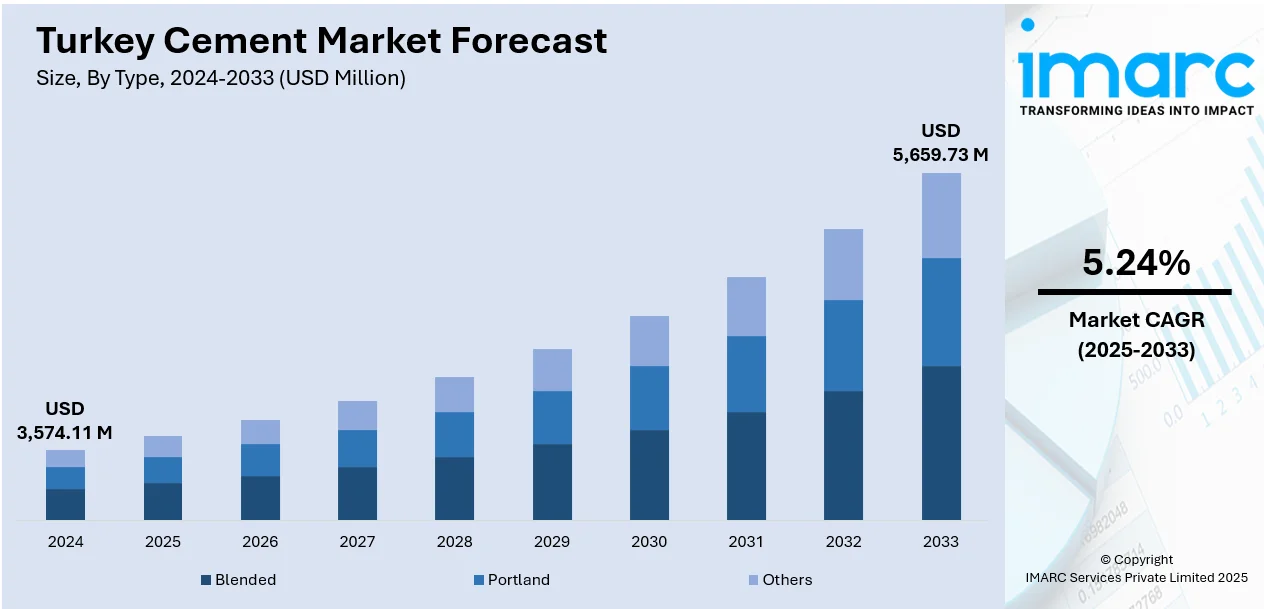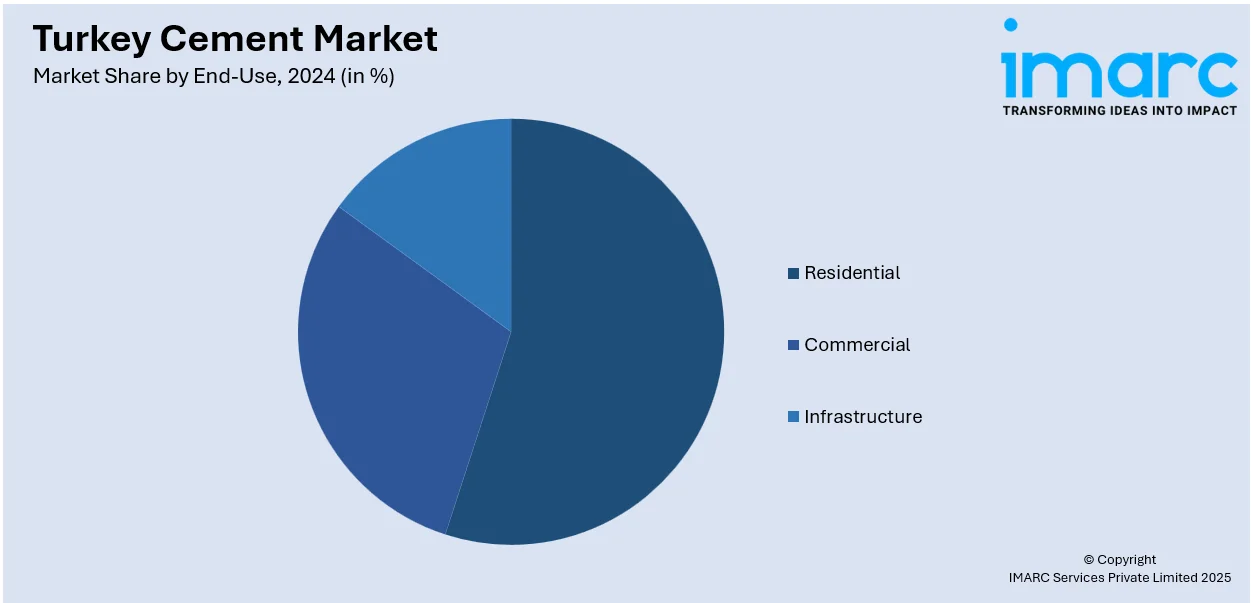
Turkey Cement Market Size, Share, Trends and Forecast by Type, End-Use, and Region, 2025-2033
Turkey Cement Market Overview:
The Turkey cement market size reached USD 3,574.11 Million in 2024. The market is projected to reach USD 5,659.73 Million by 2033, exhibiting a growth rate (CAGR) of 5.24% during 2025-2033. The undergoing steady growth, driven by urban infrastructure expansion, residential housing demand, and major reconstruction projects in earthquake-affected regions. The industry is also shifting toward low-carbon and energy-efficient production methods, aligning with EU environmental standards. Investments in alternative fuels, digitalization, and clinker capacity upgrades are strengthening competitiveness. Export activity remains robust, particularly to the Middle East and Africa. Government-backed infrastructure initiatives further support market momentum. Turkey cement market share is increasingly influenced by sustainability and regional trade dynamics.
|
Report Attribute
|
Key Statistics
|
|---|---|
|
Base Year
|
2024
|
|
Forecast Years
|
2025-2033
|
|
Historical Years
|
2019-2024
|
| Market Size in 2024 | USD 3,574.11 Million |
| Market Forecast in 2033 | USD 5,659.73 Million |
| Market Growth Rate 2025-2033 | 5.24% |
Turkey Cement Market Trends:
Growing Focus on Sustainability and Innovation
Turkey cement market is being reshaped by a dynamic blend of sustainability and digital transformation. Cement producers are increasingly adopting eco-friendly production methods such as green cement formulations, alternative fuels, and waste-heat recovery systems, aligning with strict environmental regulations and carbon reduction goals. The rise of blended cements using supplementary materials like fly ash, slag, and natural pozzolans is gaining momentum, reducing clinker content and emissions while improving product performance. Meanwhile, Industry 4.0 applications including real-time data monitoring, predictive maintenance, and automation – are enhancing operational efficiency, resource optimization, and waste minimization. These trends reflect a broader shift toward smarter, more resilient supply chains and production processes. Overall, sustainability-driven innovation combined with digital technologies signals a transformative future for cement manufacturing in Turkey best captured by the evolving landscape of Turkey cement market trends.

To get more information on this market, Request Sample
Digital Transformation of Production and Supply Chains
Digitalization is reshaping the operational dynamics of the Turkish cement sector, with advanced analytics and smart manufacturing increasingly at the forefront. Companies are investing in real-time monitoring systems, predictive maintenance tools, and automated quality control processes that significantly boost production reliability and curtail operational costs. Integrated digital platforms streamline raw material management, while AI-driven logistics systems enhance supply chain responsiveness. Remote plant operations, supported by IoT-enabled sensors, enable efficient resource oversight and rapid decision-making. In April 2024, Sabancı Holding—via its cement divisions Çimsa and Akçansa—announced major investments aimed at accelerating digital transformation across its cement operations, including cloud-based systems and green hyperscale data centers. These initiatives not only ensure greater precision in cement formulation but also contribute to reduced environmental impact through optimized energy use. Furthermore, the deployment of Building Information Modeling (BIM) in construction projects is fostering stronger collaboration between cement producers and end-users. Such innovations are instrumental in supporting Turkey cement market growth, especially as the country aligns its industrial capabilities with global smart infrastructure programs.
Rise in Green Construction and Infrastructure Projects
The rise of sustainable construction practices is having a transformative impact on cement demand and formulation across Turkey. Government-backed green building certifications and urban infrastructure upgrades are generating a steady demand for high-performance, eco-friendly cement varieties. These include products with lower embodied carbon, higher durability, and improved thermal efficiency. Cement is increasingly being tailored to meet the needs of energy-efficient buildings, smart cities, and resilient public infrastructure. Turkey’s strategic push toward decarbonized urban growth is also stimulating research into alternative binders and carbon capture integration within cement plants. As construction firms seek materials that support long-term sustainability, cement producers are responding with versatile offerings suited for a range of environmental conditions. This shift is fostering collaboration across the construction value chain and reshaping design priorities. These dynamics are contributing significantly to the market, particularly as the country positions itself as a regional leader in climate-resilient infrastructure development.
Turkey Cement Market Segmentation:
IMARC Group provides an analysis of the key trends in each segment of the market, along with forecasts at the country and regional levels for 2025-2033. Our report has categorized the market based on type and end-use.
Type Insights:
- Blended
- Portland
- Others
The report has provided a detailed breakup and analysis of the market based on the type. This includes blended, Portland, and others.
End-Use Insights:

- Residential
- Commercial
- Infrastructure
A detailed breakup and analysis of the market based on the end-use have also been provided in the report. This includes residential, commercial, and infrastructure.
Regional Insights:
- Marmara
- Central Anatolia
- Mediterranean
- Aegean
- Southeastern Anatolia
- Blacksea
- Eastern Anatolia
The report has also provided a comprehensive analysis of all the major regional markets, which include Marmara, Central Anatolia, Mediterranean, Aegean, Southeastern Anatolia, Blacksea, and Eastern Anatolia.
Competitive Landscape:
The market research report has also provided a comprehensive analysis of the competitive landscape. Competitive analysis such as market structure, key player positioning, top winning strategies, competitive dashboard, and company evaluation quadrant has been covered in the report. Also, detailed profiles of all major companies have been provided.
Turkey Cement Market News:
- In May 2024, Limak Cement Group advanced its innovation and sustainability agenda, marking significant strides toward becoming a leading force in Turkey’s cement sector. With multiple global breakthroughs and enhanced environmental initiatives, the company reinforced its commitment to future-ready production practices.
- In November 2024, Limak Cement successfully completed hydrogen fuel trials at its Ankara plant, blending hydrogen with conventional fuel in the preheating tower. The test showcased safe and efficient integration, marking a key milestone in greener cement production and reinforcing the company’s commitment to sustainable industrial innovation.
Turkey Cement Market Report Coverage:
| Report Features | Details |
|---|---|
| Base Year of the Analysis | 2024 |
| Historical Period | 2019-2024 |
| Forecast Period | 2025-2033 |
| Units | Million USD |
| Scope of the Report |
Exploration of Historical Trends and Market Outlook, Industry Catalysts and Challenges, Segment-Wise Historical and Future Market Assessment:
|
| Types Covered | Blended, Portland, others |
| End-Uses Covered | Residential, Commercial, Infrastructure |
| Regions Covered | Marmara, Central Anatolia, Mediterranean, Aegean, Southeastern Anatolia, Blacksea, Eastern Anatolia |
| Customization Scope | 10% Free Customization |
| Post-Sale Analyst Support | 10-12 Weeks |
| Delivery Format | PDF and Excel through Email (We can also provide the editable version of the report in PPT/Word format on special request) |
Key Questions Answered in This Report:
- How has the Turkey cement market performed so far and how will it perform in the coming years?
- What is the breakup of the Turkey cement market on the basis of type?
- What is the breakup of the Turkey cement market on the basis of end-use?
- What is the breakup of the Turkey cement market on the basis of region?
- What are the various stages in the value chain of the Turkey cement market?
- What are the key driving factors and challenges in the Turkey cement?
- What is the structure of the Turkey cement market and who are the key players?
- What is the degree of competition in the Turkey cement market?
Key Benefits for Stakeholders:
- IMARC’s industry report offers a comprehensive quantitative analysis of various market segments, historical and current market trends, market forecasts, and dynamics of the Turkey cement market from 2019-2033.
- The research report provides the latest information on the market drivers, challenges, and opportunities in the Turkey cement market.
- Porter's five forces analysis assist stakeholders in assessing the impact of new entrants, competitive rivalry, supplier power, buyer power, and the threat of substitution. It helps stakeholders to analyze the level of competition within the turkey cement industry and its attractiveness.
- Competitive landscape allows stakeholders to understand their competitive environment and provides an insight into the current positions of key players in the market.
Need more help?
- Speak to our experienced analysts for insights on the current market scenarios.
- Include additional segments and countries to customize the report as per your requirement.
- Gain an unparalleled competitive advantage in your domain by understanding how to utilize the report and positively impacting your operations and revenue.
- For further assistance, please connect with our analysts.
 Request Customization
Request Customization
 Speak to an Analyst
Speak to an Analyst
 Request Brochure
Request Brochure
 Inquire Before Buying
Inquire Before Buying




.webp)




.webp)












